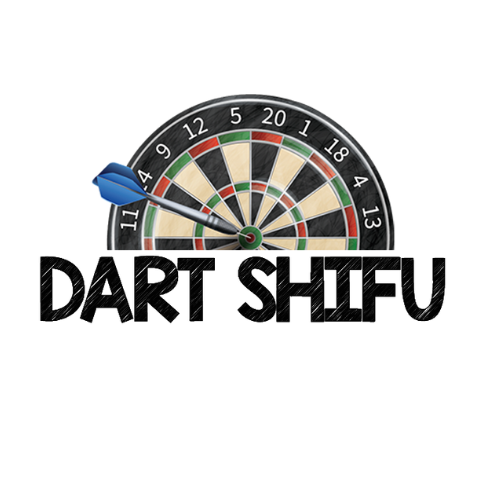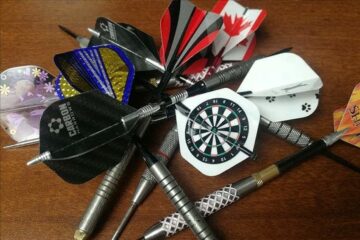To hold a dart, grip it firmly with the tips of your fingers and position your hand at eye level. Maintaining a relaxed and stable arm, aim and release the dart towards the target.
When it comes to playing darts, the way you hold the dart can greatly impact your accuracy and consistency. Whether you are a beginner or a seasoned player, mastering the correct grip is essential for improving your game. We will explore the proper technique for holding a dart and provide you with some tips to enhance your throwing skills.
By following these guidelines, you will be able to control your dart’s trajectory and hit the bullseye with precision. So, let’s dive in and learn how to hold a dart like a pro.
Understanding The Dart Grip
Understanding the dart grip is essential in mastering how to hold a dart. With a proper grip, you can improve your accuracy and control, leading to better performance in dart games.
Types Of Dart Grips
When it comes to honing your darts skills, one crucial element to master is the dart grip. A solid grip can make or break your accuracy and consistency. There are various types of dart grips that players employ, depending on their personal preference and playing style.
Let’s take a closer look at some of the common dart grips:
- Front Grip
- Center Grip
- Back Grip
- Smooth Grip
The front grip, as the name suggests, involves holding the dart near the front. This grip allows for better control over the trajectory and spin, giving you a precise throw.
The center grip involves gripping the dart in the middle using your fingers, providing a balanced feel. This grip is popular among players who prefer a consistent release point.
The back grip involves holding the dart towards the rear end. This grip offers a more stable feel and is commonly chosen by players who prioritize power and velocity in their throws.
Some players prefer a smooth grip, without any specific finger placements. This grip allows for a more natural feel and free-flowing throw.
Factors To Consider In Choosing A Dart Grip
While the different types of dart grips provide different benefits, deciding on the right grip for you involves considering several factors. Here are some key factors to consider:
- Comfort: The dart grip should feel comfortable and natural in your hand, allowing you to maintain a relaxed grip throughout the throw.
- Consistency: A consistent grip enables you to replicate your throwing motion more effectively, leading to improved accuracy.
- Control: Select a grip that gives you optimum control over the dart, allowing you to focus on the target and adjust your aim as necessary.
- Release: Pay attention to how the dart releases from your fingers with different grips. Aim for a smooth and consistent release point to maximize accuracy.
- Experimentation: Don’t be afraid to experiment with different grips to find what works best for you. Each player is unique, and what may work for one might not work for another.
Understanding the types of dart grips and factors to consider in choosing the right grip will provide a strong foundation for your dart-playing journey. Remember, practice makes perfect, so grab your darts and start experimenting to find your ideal grip!
:max_bytes(150000):strip_icc()/84304410-crop-58bac8b95f9b58af5cb5b2c8.jpg)
Credit: www.liveabout.com
Proper Dart Holding Techniques
Holding a dart correctly is crucial to improve your accuracy and control in the game. By employing proper dart holding techniques, you can enhance your throwing technique and improve your performance. In this section, we will delve into the important aspects of finger placement, hand position, and wrist alignment when holding a dart.
The Finger Placement
When it comes to finger placement, finding the right grip is key. Different players may prefer different finger positions to suit their throwing style. However, there are a few common techniques that are widely used:
- Standard Grip: This grip involves placing the index, middle, and ring fingers on the front of the dart barrel. The thumb stabilizes the dart from the back with a light grip.
- Three-Finger Grip: Here, the middle finger is placed alongside the index finger on the dart barrel, which provides additional stability.
- Claw Grip: In the claw grip, the dart is held between the thumb and index finger. The other fingers stay relaxed and slightly pointed downward, giving you a controlled release.
Experiment with these grips and see which one feels most comfortable and natural to you. Remember, a proper finger placement should provide a stable and balanced hold on the dart.
The Hand Position
In addition to finger placement, the position of your hand plays a crucial role in your dart throwing technique. The way you hold the dart with your hand can significantly impact your accuracy. Here are a few hand positions to consider:
- Palm Up: This hand position involves keeping your palm facing upward. It provides a more relaxed grip and allows for a smoother release.
- Palm Down: In this position, your palm faces down towards the floor. This grip tends to provide more power and control, especially for players who prefer a forceful throw.
- Sideways Grips: Some players choose to hold their dart in a sideways position, with the palm pointing towards their dominant side. Sideways grips allow for a more natural alignment of the hand and wrist, promoting accuracy.
Experiment with these hand positions and find the one that suits your throwing style and comfort level best. Make sure your hand position promotes a fluid and consistent throwing motion.
The Wrist Alignment
Proper alignment of your wrist plays a crucial role in dart throwing. A stable and controlled wrist not only enhances accuracy but also helps in generating consistent power. When it comes to wrist alignment, consider the following:
- Straight Wrist: Aim for a straight and neutral wrist position. This means avoiding excessive bending or flexing of the wrist during your throw. A straight wrist allows for a smooth and accurate release.
- Natural Angle: Each player has a comfortable and natural angle of the wrist when holding the dart. Find this angle by experimenting with different positions. It should allow for a comfortable grip without adding unnecessary strain or tension to your wrist.
Remember, finding the right wrist alignment is essential for maintaining control and accuracy throughout your throw. Practice and adjust until you find the position that works best for you.
By applying these proper dart holding techniques, you can refine your grip, hand position, and wrist alignment, leading to improved accuracy and consistency in your dart throwing. Take the time to experiment and find the techniques that work best for you, and soon you’ll be hitting that bullseye with confidence!
Tips For Improving Dart Holding
Improving your dart holding technique is crucial to enhancing your accuracy and control on the dartboard. In this section, we will explore some valuable tips that can help you strengthen your grip, experiment with different holds, and even seek professional guidance to take your dart holding to the next level.
Exercises For Strengthening Your Grip
Having a strong grip is essential for maintaining control over your darts during your throw. Here are a few exercises that can help you strengthen your grip:
- Squeeze a stress ball or grip strengthener for a few minutes each day. This will help build the muscles in your hand and fingers that are involved in holding the dart.
- Try finger push-ups by placing your hands flat on a surface and lifting each finger separately. This exercise will not only strengthen your grip but also improve your finger dexterity.
- Consider using hand grippers to target specific muscle groups involved in holding the dart.
Experimenting With Different Grips
Everyone has their own naturally comfortable grip, but sometimes experimenting with different grips can help you find one that offers better control and accuracy. Here are a few grip variations you can try:
- The pencil grip: Hold the dart as if you were holding a pencil. This grip can provide a stable and consistent hold.
- The claw grip: Rest the dart between your index and thumb, allowing your fingers to provide additional support. This grip can provide better stability and control.
- The hammer grip: Hold the dart with a tight and secure grip, as if you were holding a hammer. This grip can offer power and stability during your throw.
Remember, finding the right grip for you may take some trial and error, so don’t be afraid to experiment until you find what works best for you.
Seeking Professional Guidance
If you’re serious about improving your dart holding technique, seeking professional guidance can provide invaluable insights and personalized advice. Consider the following options:
- Join a dart league: Participating in a local dart league can allow you to connect with experienced players who can offer guidance and share their expertise.
- Hire a dart coach: A professional dart coach can analyze your grip and throwing technique, providing specific recommendations tailored to your individual needs.
- Attend dart clinics or workshops: Look out for dart clinics or workshops in your area, where you can learn from professionals and gain practical tips to improve your dart holding.

Credit: www.dartslive.com

Credit: www.wikihow.com
Frequently Asked Questions Of How To Hold A Dart
What Is The Best Way To Hold A Dart?
To hold a dart effectively, place your fingertips towards the front of the barrel. Keep a relaxed grip and ensure that the dart’s center of gravity lines up with your fingers. Experiment with different grips to find what feels comfortable and allows for a smooth release.
What Is The Correct Way To Throw A Dart?
To throw a dart correctly, hold it with a relaxed grip, aim at the target’s center, and focus on a specific point. Use a smooth and controlled throwing motion, releasing the dart with a flick of the wrist. Practice consistently to improve accuracy and precision.
How Many Fingers Do You Hold A Dart With?
You hold a dart with three fingers.
Which Part Of A Dart Should We Hold When Throwing?
Hold the middle part of the dart when throwing to maintain balance and control.
Conclusion
To wrap up, mastering the art of holding a dart is essential for achieving precision and accuracy in your throws. By employing the correct grip, focusing on a gentle release, and maintaining a relaxed stance, you can significantly enhance your dart-throwing skills.
Remember, practice makes perfect, so take the time to hone your technique. With dedication and determination, you’ll soon be hitting bull’s-eyes like a pro. Happy dart-throwing!



